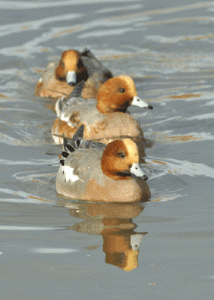Wigeon flock to Lady Fen
 The first wigeon have been recorded on 38 hectares of specially created wetland habitat next to the WWT Welney Wetland Centre, thanks to the combined efforts of Wildfowl & Wetlands Trust (WWT), WWT Consulting and the Environment Agency (EA), who funded the project.
The first wigeon have been recorded on 38 hectares of specially created wetland habitat next to the WWT Welney Wetland Centre, thanks to the combined efforts of Wildfowl & Wetlands Trust (WWT), WWT Consulting and the Environment Agency (EA), who funded the project.
Since receiving planning permission in January 2008, the WWT at Welney have transformed this farmland into wet grassland by digging a system of ditches, channels and scrapes, inserting a waterproof liner to protect surrounding farmland and seeding it with native grasses. The first 100 wigeon were recorded on the new wetland in the first week of December with 114 teal, 29 mallard and 15 pintail. Other sightings on the land include eight snipe, over 200 golden plover, more than 100 lapwing, a short-eared owl and 200 whooper swans roosting on the scrapes.
“We started to wet-up the site for the first time at the beginning of November and already it is being used by good numbers of birds,” said Emma Hutchins, head of reserves management for WWT. “The site is still in an establishment phase (the last area of grass was only seeded in October) but already it is attracting the desired wildlife.”
Back in 2006, the EA purchased the former agricultural land, known as Lady Fen Farm, to establish wet grassland for wigeon as part of the compensatory habitat creation for flood defence work carried out on the Middle Level Barrier Bank of the Ouse Washes. This involved protecting sections of the Barrier Bank from erosion by installing concrete panels along the foot of bank. The land is also a part of the Environment Agency’s wider biodiversity action plan.
Dr Geoff Brighty, area manager for the Environment Agency said: “The purchase of Lady Fen has enabled us to get the best of both Environment Agency worlds – to help us protect local communities from flooding while creating a wildlife habitat which is good for birds. We are delighted that WWT are managing Lady Fen on our behalf and we look forward to it attracting even more wildlife.”
WWT Welney holds internationally important wintering populations of wigeon. The Ouse Washes form the largest example of internationally important washland in Britain, and is the most important area of lowland wet grassland for birds in Britain

